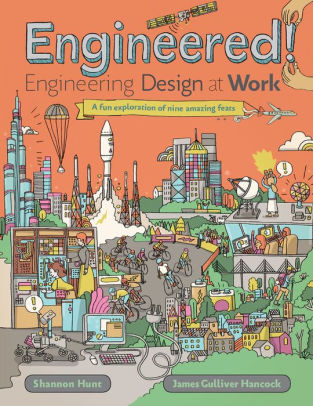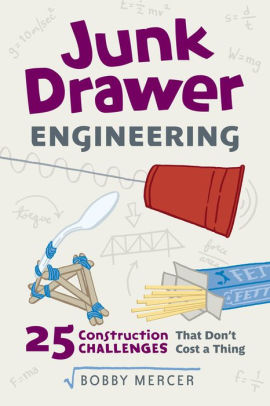STEM is big in schools and publishing today, and many educators add an A to make STEAM: Science, Technology, Engineering, Art, and Math. Engineering ties all those together: applied science using math and technology, often to create an object not only useful but beautiful. Earlier we posted a roundup of recent series novels stressing STEAM for girls. Most of these fields have been dominated by males, engineering especially. Many (by no means all) boys tend to be hands-on, building, taking apart, knocking down. More than girls, I think—and I also think that will always be the case. Girls who are interested in math and engineering, as my own daughter was, should be encouraged along those lines. But at the same time, boys should certainly not be discouraged.
Fortunately, excellent books on the many kinds of engineering (theoretical, technological, or practical) are published for kids every year. We’ve reviewed several, and know of others that we haven’t got around to reviewing (yet!). If your boy or girl shows a bent for building, well . . . there’s a book for that! Such as
- How Does My Home Work? by Chris Butterworth. This engaging picture book for the younger set satisfies youthful curiosity about the nuts-and-bolts of everyday living: electrical systems, plumbing, heat and air.
- The Way Things Work and The Way Things Work Now by David Macaulay. David Macaulay is the go-to guy for structural engineering. The Way Things Work, originally published in the 1990s, became a favored reference for kids (and adults!) asking how-and-why questions. The updated version covers electronics, computing, and smartphones, and quantum technology. Many illustrations by the author help sort out the technical terms.
- And speaking of David Macaulay, his specialized construction books focusing on Pyramid, Cathedral, Castle, and City examine how the ancients and the middle ages did it.
- Crossing on Time by David Macaulay is a travelogue, personal narrative, and step-by-step guide to building the luxurious ocean liners of recent history.
- The Building by Design series, including Engineering the Leaning Tower of Pisa, Engineering the Panama Canal, Engineering the Taj Mahal, etc., published by Abdo Publishing. This series for ages 7-10 is more workmanlike than brilliant, but include clear, comprehensive information in a compact format. “Stop and Think” sections at the end of each book offer writing prompts and project ideas.


- Engineered! Engineering Design at Work by Shannon Hunt and James Gulliver Hancock. This informational picture book begins with seven steps required by any engineering project, then goes on to describe specific engineering challenges in city planning, computing, biomedicine, space exploration, and more. Simple illustrations, sidebars, and a glossary make an appealing package.
- The Wright Brothers: Nose-Diving into History. Failure can be a crucial part of success, as any inventor will tell you. This friendly introduction to the Wright Brothers for early middle grades touches on the many failures of human flight before the Wrights got a chance to take their shot. First to Fly by David Craig and Peter Busby is another great Wright-brothers story, an informational picture book for middle grades published in 2003.
- The Art of the Catapult by William Gurstelle. Did your child’s history studies this year pique their interest in ancient artillery? Check this book out to learn to build authentic catapults. If there’s no neighborhood war on the horizon, the kids can always prepare for “Punkin Chunkin’ this fall.
- The Boy Who Harnessed the Wind by William Kamkwamba. The true story of a young man from Malawi who used junkyard parts, basic information from the school library, and lots of ingenuity to bring wind power to his village. We reviewed the middle-grade version, but the story is also available as a picture book.
- Elon Musk and the Quest for a Fantastic Future by Ashlee Vance. Musk is more of a visionary than an engineer, but the biggest project begin with a visionary. This biography for middle-grades and up could inspire kids to think BIG.
- Wile E. Coyote, Physical Science Genius.series. The continually-frustrated coyote might finally catch that elusive roadrunner if he would only learn some science! Experiments with energy, states of matter, simple machines, and forces of motion demonstrate how his elaborate traps could never work. Lots of fun, and more titles to come.
- The Kids’ Book of Simple Machines by Kelly Doudna. Machines are where it’s at! Each new machine provides a platform for other, more advanced machines, and this is a great place to start. Betsy says, “A must for kids of love to tinker and find out how things work.”
- The Nick and Tesla series. Nick and Tesla are twins who are sent to live with their very eccentric inventor Uncle Newt whilst their parents are on some mysterious “work” trip. In Uncle Newt’s lab they put their own science skills to the test to solve a mystery. The books are fast-paced and filled with several sets of directions for gadgets and experiments young readers can do at home. Great fun!
- Junk Drawer Engineering by Bobby Mercer. We reviewed Junk Drawer Physics already. This volume in the series focuses more on structures: The “25 Construction Challenges that Don’t Cost a Thing” are grouped into three sections under “Energy,” “Construction,” and “Waves.” Aspiring builders can try their hands at roller coasters, zip lines, towers, bridges, and much more, while learning the scientific principles behind them. Addressed more to teachers than children, but any capable reader who also loves building will devour it.


- Electronics for Kids: Play with Simple Circuits an Experiments with Electricity! by Oyvind Nydal Dahl. Betsy says, “I haven’t reviewed this, but I should. It’s outstanding and a terrific introduction to electrical engineering (and working with circuits/computers)”
- Mini Weapons of Mass Destruction series by John Austin. Betsy again: “I should review this series, too! My boys LOVE it and so do their friends.” Spitwad warfare, Ninja weapons, secret agent arsenal—what’s not to like? There are five volumes in the series so far, each about 250 pages with large diagrams and brief text.
If you know of any more great engineering books for kids, let us know in the comments!
Stay Up to Date!
Get the information you need to make wise choices about books for your children and teens.
Our weekly newsletter includes our latest reviews, related links from around the web, a featured book list, book trivia, and more. We never sell your information. You may unsubscribe at any time.
Support our writers and help keep Redeemed Reader ad-free by joining the Redeemed Reader Fellowship.
Stay Up to Date!
Get the information you need to make wise choices about books for your children and teens.
Our weekly newsletter includes our latest reviews, related links from around the web, a featured book list, book trivia, and more. We never sell your information. You may unsubscribe at any time.
FREE Bible Guide!
Get a guide to the Best Bibles for Children and Teens. Perfect for an Easter gift.
We'd love to hear from you!
Our comments are now limited to our members (both Silver and Golden Key). Members, you just need to log in with your normal log-in credentials!
Not a member yet? You can join the Silver Key ($2.99/month) for a free 2-week trial. Cancel at any time. Find out more about membership here.
2 Comments
Leave a Comment
You must be logged in to post a comment.


My daughter is applying to university Mech Engin programs, but maybe it’s never too late for an engaging “kid’s book” on the subject? I surely needed this list ten years ago!!
Alison,
My approach to a subject I don’t know much about–especially STEM subjects–is to find a good kids’ book on it!